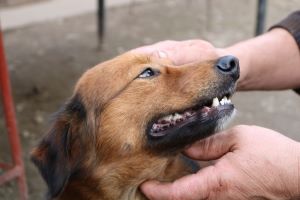
Your Fido is a lively pup, filled to the brim with boundless energy and excitement about life in general.
Chew toys and playing fetch, specifically, but he’s not fussy.
Then, suddenly, he’s not so lively.
In fact, he seems downright listless, doesn’t want to eat, and keeps pawing at his face.
You try to check things out, but he won’t let you near his mouth.
Oh no! What if it’s a tooth infection? What should you do? Is it serious? How do you know, anyway?
Don’t worry; we’ve got you covered.
It’s scary when your fur kid isn’t himself and when he could be seriously ill.
That’s why we’ve answered all these questions and a few more to help you out.
Read on to find out.
What Causes Tooth Abscesses in Dogs?
Tooth infection is typically quite painful, and the causes are legion. The most common cause is a bacterial infection. Here, the bacteria invade deep into the tooth structures and gums, usually accompanied by periodontal disease and gum disease (gingivitis).
Cracked or fractured teeth also tend to quickly develop tooth infection and root abscesses. In this case, bacteria gain easy access to the tooth root through the crack. This is typically caused when your pup bites down in something hard. Examples include bone, ice cubes, cow hoofs, rocks, and hard nylon toys.
Most commonly, dogs develop tooth abscesses and related dental disease in their upper fourth premolar. Say what now? That’s the large cheek tooth you’ll find on each side of your pup’s upper jaw. That’s because Fido uses this tooth to crush food, so if he bites down on something hard, that’s the one that would get damaged through a slab fracture. That means that a slab-shaped piece shears off from the side of his tooth. Ouch! This tooth could also crack down the center. Either way, it sounds super painful.
Another common site for painful bacterial infection is the canine teeth (fang teeth) since they’re easily broken.
What are the Symptoms of a Dog’s Tooth Abscess?
The symptoms indicating tooth infection and dental disease are often hard to notice since they’re much the same as other, non-related conditions.
If your pup’s abscessed tooth is his carnassial tooth (that’s the upper fourth premolar), he’ll likely have some swelling just below the eye. That’s because this tooth’s roots go nearly all the way to his eye sockets. Yikes!
Abscessed teeth are usually quite painful, but pups don’t always show obvious signs of mouth pain. So, you’ll need a keen eye to spot these. Here are some common symptoms to look out for:
- Bad breath (worse than the usual doggy breath)
- Pawing the mouth
- Rubbing the face on the ground
- Unwilling to eat or chew on toys
- Using only one side of his mouth for chewing
What Can You Do For a Dog with a Tooth Abscess?
When you notice that your pup has any of the symptoms mentioned above, or anything else that makes you a bit worried, the first step is a vet visit or a trip to the veterinary dentist. The vet will examine your Fido and determine whether or not he has an abscessed tooth or any other dental disease.
Usually, the vet can find signs of tooth infection while your pup is awake. In some cases, the poor pup is in too much pain and wouldn’t allow anyone near his mouth. In that case, the vet or veterinary dentist might sedate him to have a closer look. The vet would need to do a complete oral exam or dental x-rays.
Typically, the vet would prescribe an antibiotic and pain meds to help your pup along. If there’s an obvious source of infection, the vet will probably remove this as well. Usually, this takes the form of tooth extraction or root canal therapy. The first option results in tooth loss for Fido, while the second usually means keeping it. It depends on what state the tooth is in.
Both tooth extraction and root canal therapy are forms of surgical intervention, so your pup will need anesthesia.
After the treatment, your pup will take some time to recover, and he might be in quite a lot of pain for a while still. Since the treatment happened in his mouth, he will probably struggle to eat for a while, too. Many dogs find this painful process traumatic, so they usually don’t like preventative dental care either. That means you could have a hard time brushing Fido’s teeth and doing other things to keep his gums and teeth healthy.
Can a Tooth Abscess Kill A Dog?
The short answer is yes, in the long run. If you leave your pup’s tooth abscess untreated, the infection will spread. This could lead to severe complications, which could kill your pup. While the bacterial infection spreads through his body, he’ll be in pain too, so it will probably be a slow, agonizing process. That’s not a pretty picture, so we recommend getting your pup to the vet the moment you notice something off.
Is a Tooth Abscess in a Dog an Emergency?
A dog’s tooth abscess is a dental emergency. While you don’t necessarily have to rush to the emergency room, you must get Fido to the vet without delay. The sooner you sort out this bacterial infection, the lower the risk of serious complications.
If your pup’s tooth abscess has been brewing unnoticed for a while, you might have a medical emergency on hand. In this case, your pup will be pretty ill, and you probably won’t think twice about an emergency room visit.
How Much Does it Cost To Treat a Dog’s Tooth Abscess?
Unfortunately, treating dental infection in dogs can be very costly. This is mainly due to the surgical intervention that’s usually needed. Surgery and the accompanying anesthesia cost quite a bit and require more than one person to perform the procedure.
In some cases, dogs have bad reactions to anesthesia or other complications. This increases the cost even more.
Can I Leave a Dog’s Tooth Abscess Untreated?
If you leave your pup’s tooth abscess untreated, he could suffer from a lot of pain, and even lose a few teeth. The infection can spread to other teeth and to the rest of his face. It could even affect his eyes. This is a bleak picture, and it means that your poor Fido could suffer quite a bit.
Bacterial infection in Fido’s teeth can spread to the surrounding bone, from where it can enter his bloodstream. This infection will spread, potentially affecting his organs, such as the liver, heart, and kidneys. Once it reaches the organs, this bacterial infection could cause significant damage. The longer you leave it, the worse the damage will be.
An untreated tooth abscess and accompanying dental infection could soften the gums, making them recede. Here, your pup will probably suffer some tooth loss.
Generally, your pup’s quality of life will be negatively affected while that abscess lingers. So, it’s better to get it treated sooner rather than later for his physical health and mental well-being.
In some mild cases, you can treat your dog’s tooth abscess at home. It’s best to have the vet check him out first, though, just to be sure.
How can I Prevent Tooth Abscesses in Dogs?
Sometimes, a Fido’s tooth abscess is unavoidable. Just like cavities in humans, I guess. There are some things you could do to reduce the risk, though. The first is maintaining good oral hygiene. Here, you could brush Fido’s teeth regularly and take him for an annual dental check-up. Again, just like with humans. In some cases, your vet could even give you pointers on upping the oral hygiene game.
Then, there’s keeping an eye on what your pup chews. You could help him steer clear of hard toys, bones, ice cubes, and other hard stuff that could fracture his teeth.





